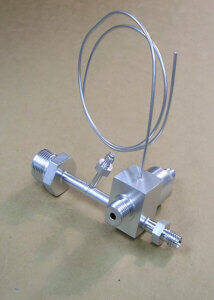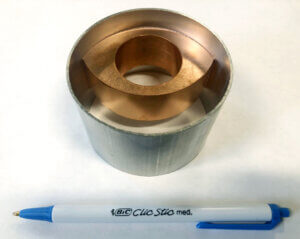Ask the Expert: Solar Atmospheres Director of Sales Answers Questions About Vacuum Brazing
 1. I want to join 304 stainless steel to copper, can I utilize vacuum brazing for this?
1. I want to join 304 stainless steel to copper, can I utilize vacuum brazing for this?
Yes. 304 stainless steel may be effectively vacuum brazed to copper using various braze filler metal (BFM) types and chemistries. Filler metals based on gold, silver, and nickel can work. Careful attention must be given to the joint configuration since copper expands slightly more than 304 stainless steel. The copper will be very low in strength afterwards, so it may yield to match the size of the stainless steel without notable distortion.
2. My parts must be fit for cryogenic service, will the braze joint survive that?
Brazed assemblies are routinely placed into service as low as 4°K. As always, there are design considerations and limitations, however gold and silver-based filler metals are commonly utilized in this kind of application.
 3. I have a very complicated assembly and do not believe it can be brazed all at once. Plus, I need to inspect some joints that would be impossible to inspect if I brazed all at once. Are there options to braze an assembly in multiple braze cycles?
3. I have a very complicated assembly and do not believe it can be brazed all at once. Plus, I need to inspect some joints that would be impossible to inspect if I brazed all at once. Are there options to braze an assembly in multiple braze cycles?
Yes! An expert braze supplier can help organize a multi-step brazing process. Consideration must be given to the base materials and BFMs so that the original braze joints do not remelt during subsequent braze cycles. Typically, the first cycle runs hotter than a subsequent cycle and with a BFM that will not remelt during a subsequent cycle. Sometimes the BFM is so active in diffusing a constituent into the base material(s) that returning to the same temperature may not cause a remelt situation. Multi-step brazing can be a convenient and effective tool in the manufacturing of high value medical components.
4. I am having issues with small diameter tubing becoming blocked during the brazing process. How can I prevent this from happening?
This problem can be a challenge, but it can be solved! There are numerous methods that may be employed to prevent it, the most effective is using just the right amount of BFM. If the joint is small and the area is low, it may be surprising just how little BFM is needed to effectively braze the joint. Calculate the cubic area of the joint and try using only slightly more BFM than the calculated area. A joint design prone to blockage is a counterbore receptacle with the same ID as the tubing. This allows the BFM to travel right to the tubing ID by capillary action. Use a space at the end of the tube to create a break in the capillary action or design the joint so the tubing may protrude slightly beyond the joint area. These methods create a more difficult path for the BFM to travel to the tube end and will reduce the risk of blockage. Using just the right amount of BFM and creating a difficult path to the tube end is a recipe for success.
 5. My customer wants a big braze fillet similar to a weld fillet. Is that the right approach?
5. My customer wants a big braze fillet similar to a weld fillet. Is that the right approach?
This subject arises from time-to-time, and the reason must be questioned. Unlike a weld fillet, which creates strength in the joint, a big fillet in brazing adds nothing to the strength of the joint and wastes BFM, and it actually can be detrimental. It’s what is on the inside that counts. In fact, certain BFMs can be brittle in a large fillet due to a concentration of undiffused low-melt constituent. In this case, the fillet could crack under even mild fatigue and propagate into a catastrophic failure. In brazing, a slight continuous witness of the BFM at the joint interface is typically the most appropriate visual inspection criteria.
For more information: https://solaratm.com/vacuum-heat-treating/brazing
And featured in Today’s Medical Developments: https://www.todaysmedicaldevelopments.com/article/vacuum-brazing-questions-with-mike-moyer-solar-atmospheres

 5. My customer wants a big braze fillet similar to a weld fillet. Is that the right approach?
5. My customer wants a big braze fillet similar to a weld fillet. Is that the right approach?